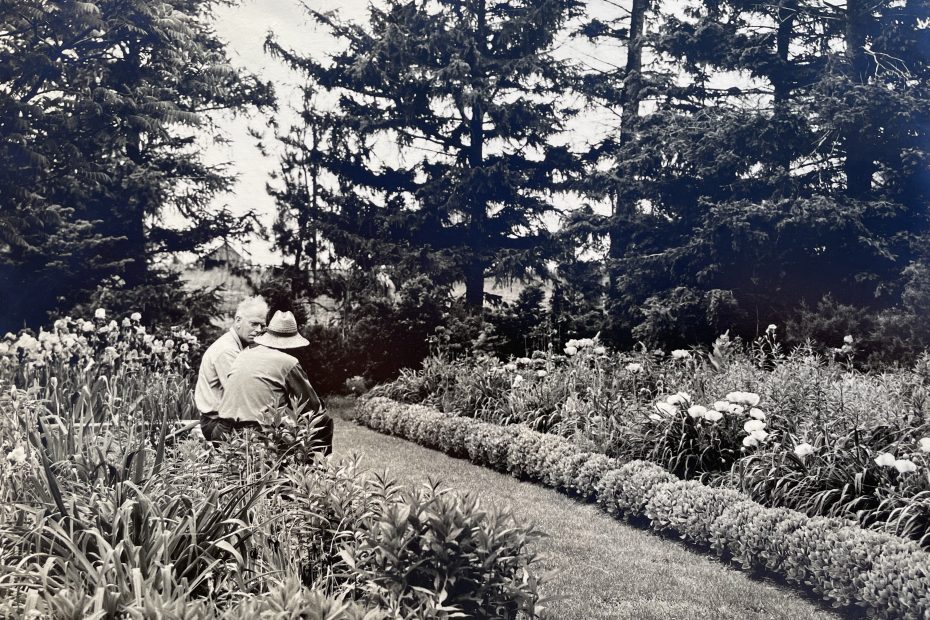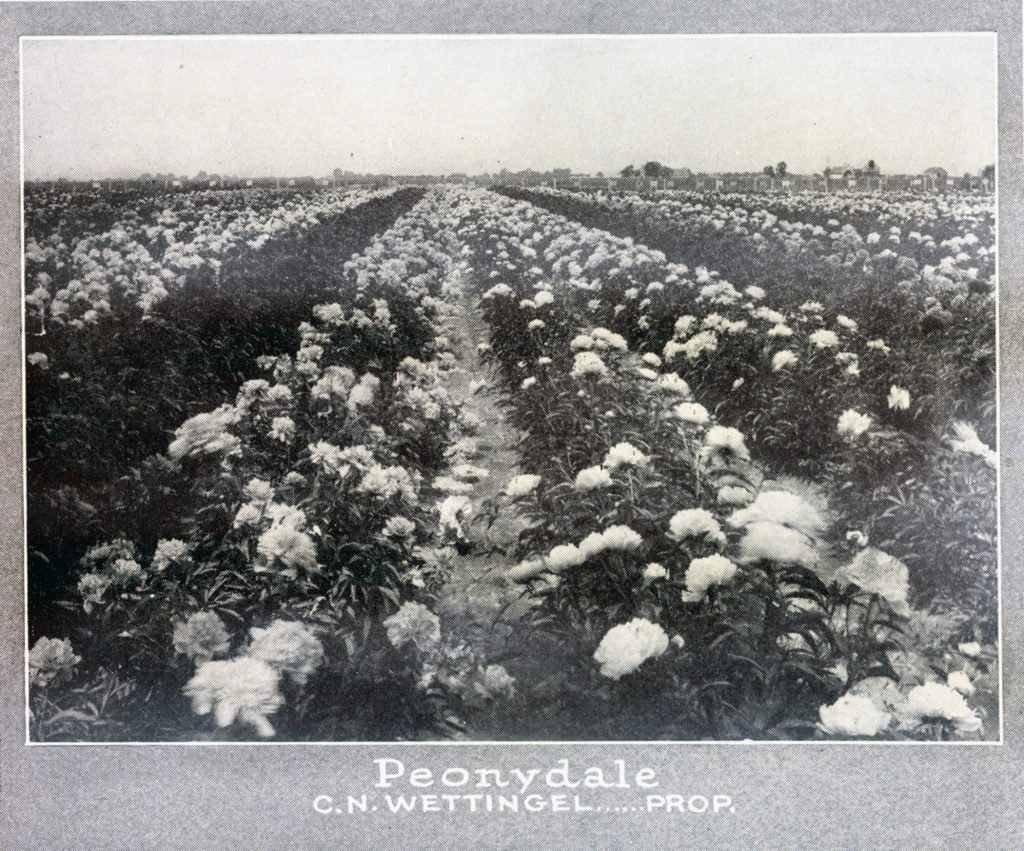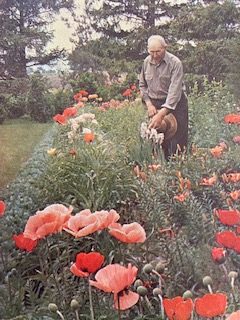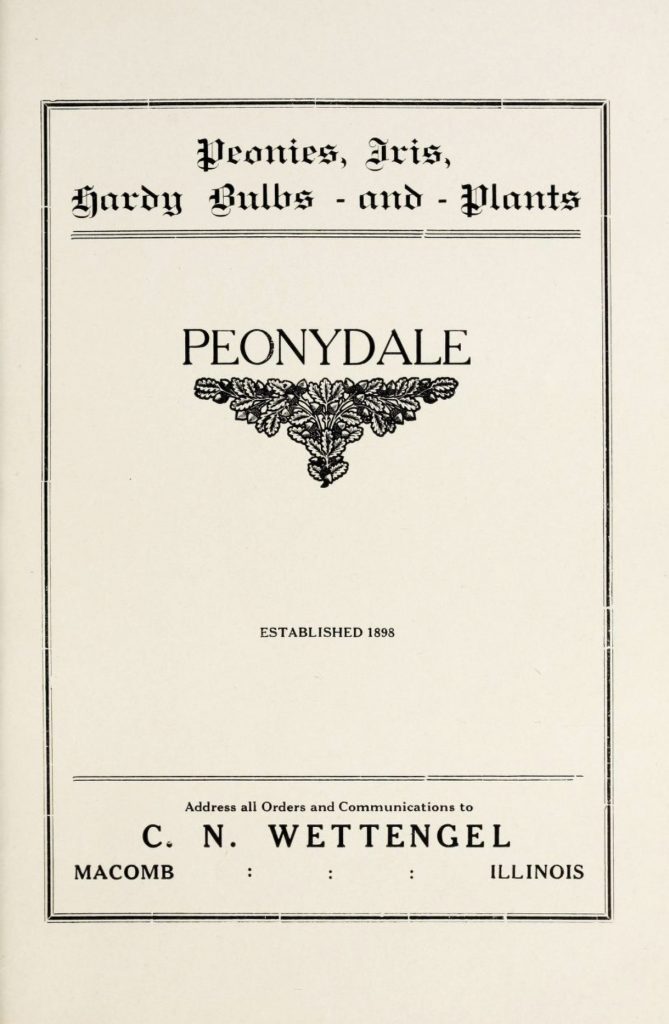Written by Sue Marshall
Originally appeared in Macomb’s Community Brief in May 2022
Spring, though reluctant to arrive this year, is in the air with trees leafing, emerald grass, and the perfume of blooms. Soon the peonies, abundant in our town and region, will be in blossom reminding some of our older residents to recall a nursery here called Peonydale.
door to the property in the 80s many decades after it was no longer in operation. We learned about it as there was a 1940s pickup truck parked there with “CN Wettengel, Peonydale” painted on the door.
The owners, Thelma and Arthur Wettengel, were part-time residents and while they were in Oklahoma, we took an opportunity one early spring to peek behind their sprawling old home, barns, and outbuildings. We found a botanical garden full of planted and naturalized beds, shrubs, and towering trees. Gardens wound down a slope to a handmade rock bridge and field.
We were stunned-and in a good way! This was dropped in the middle of cornfields—a field away from our home!
I have found some information about them and the business in newspaper articles, online, and in contacts through social media groups here. In 2021, another Museum volunteer found family descendants living in Oklahoma. I reached out to them and they eagerly were on board for sharing information with the public.
Like many rural communities, the City of Macomb located in McDonough County has a rich history that has been documented by local families, the WIU Archives, Western Illinois Museum, and McDonough County Genealogical Society. Early settlers looking for land began arriving in the 1820s. McDonough County was incorporated in 1826, and Macomb, in 1830. The designation of Illinois as part of the Military Tract, land that was set aside for soldiers who served in the War of 1812 as payment for their service, began the development of west-central Illinois.
From 1840 thru 1880 more Germans immigrated to the United State than from any other country, including Charles W Wettengel who immigrated in 1850. He traveled to Pittsburgh then Quincy and arrived in Colchester where he opened the town’s first shoe store in 1857. There he met his wife, Sarah (Zimmerman) also a German immigrant. In 1864 they purchased 80 acres of former military tract land and established a self-sustaining farm there, eventually owning 160 acres. They had six children including Charles Neidel, born in 1872, who eventually established Peonydale in 1898.
Charlie was born a naturalist; as a child, he collected prairie plants in the woods walking back and forth to the Yard School; others gave him plants that he planted at the farm. This hobby was not encouraged, but tolerated, after schoolwork and chores.
From the 1850s thru the 1900s peonies were beginning to be imported from Holland and France and cut blooms were in great demand as refrigeration and transportation systems developed. Nurseries began on the east coast and many early ones in Minnesota, Iowa, Wisconsin, and Illinois were established, and are still operating. When Charlie was 14, he ordered his first peony from France; In 1898, bought his first dozen plants from Holland. He held a flower show in Macomb in 1910 and made $75 and he continued to buy and cultivate peonies and iris. His father gave him seven acres of his own when he demonstrated he could make more money from flowers than grain. He took wagons of cut flowers to the Macomb train depot to be sold in Chicago markets. He developed an extensive inventory and ordered many varieties from Mid-western nurseries and shipped rootstock across the country.
Over the years he added trees, shrubs, perennials, and bulbs and as reported in 1935 had over 200,000 plants; in 1955, an article notes that thousands of people would visit Peonydale during the growing season. I’ve heard wonderful stories from people who visited to enjoy the beauty and aroma of acres of blooms. I am continuing to seek out those stories of people who visited, knew the family, and have photos that can be preserved at the Western Illinois Museum.
Over those long years, Peonydale declined as many did for many nurseries; peonies were not as popular, the Depression, shipping costs, the expanding availability of plant varieties, and the aging and passing of owners; Charlie lived there his entire life and died in 1963.
From 1919 to 1928, Charlie developed 11 varieties that are registered with the American Peony Society. There are descriptions of the plants but alas, no photos. I and the family are very much interested in finding Charlie’s varieties as well as plants that were purchased there.
Charlie, his wife, Irma (Hainline), his parents, and brother John (who was a local carpenter) are buried at beautiful Oakwood Cemetery which will be awash in peony blooms in just a few weeks.
Any information will be gratefully received and can be sent to the Western Illinois Museum at 201 S. Layfayette, Macomb, IL, 62326. You can call at 309/837-2750; text to 309/837-2613; or send an email to info@wimuseum.org.



